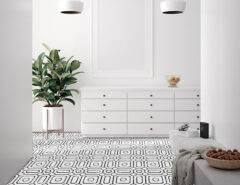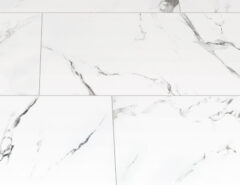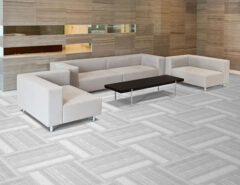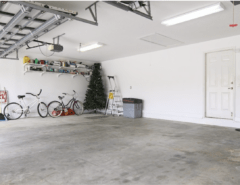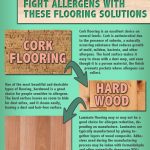There’s a reason the saying “strong as an oak” has lasted throughout the ages. Featuring Jasper European Brushed Oak Collection. SKU: 10103799
If you’re looking into buying new flooring for your home, there’s a plethora of options to choose from ranging from natural bamboo and stone tile to carpet and vinyl. If you’re wondering whether you can buy flooring that’s durable, affordable, and low VOC, the answer is absolutely!
Choosing non-toxic flooring will keep your family safe, and it’s also a more eco-friendly and sustainable choice. Check out this helpful guide that explains the ins and outs of buying non-toxic flooring for your home.
First of All: What is Non-Toxic Flooring, Exactly?
The term non-toxic flooring refers to materials that don’t emit harmful chemicals or vapors that can get into the air, causing humans and pets to breathe in these dangerous components. Most non-toxic flooring includes all-natural materials like hardwood or tile made of natural stone. However, there are some synthetic, man made flooring options that are non-toxic, too. The key is to understand how to identify these types of flooring so you’re making the right choice for your home.
What are the advantages of non-toxic flooring? There are actually many. First, electing to install non-toxic flooring options means that you’re deciding to use products that are harvested and made in a sustainable way. Toxic flooring materials are made in factories and treated with a variety of dangerous chemicals. Not only do these chemicals get into the air you breathe inside your home, but they also seep into our environment, leaching into the soil and waterways. If you’re concerned about the environment and want to make a difference, choosing non-toxic flooring is a much better alternative.
Another benefit to non-toxic flooring is that you won’t have to worry about breathing in harmful chemicals that can make allergies and respiratory conditions worse. Even if you don’t have asthma, flooring that is treated with chemicals can make it more difficult to breathe. Indoor air quality plays a huge role in our health, and that’s why it’s always best to install non-toxic flooring in your home. When you buy this type of flooring, you’re also “voting” to choose safer options with your dollars. Buying non-toxic flooring decreases the demand for other options that are bad for your body and the environment as a whole. Thanks to its healthier materials and sustainability, toxic free flooring is clearly the best choice.
How to Shop for Non-Toxic Flooring
As you shop for non-toxic flooring options, it’s important to know exactly what to look for. Most products will include the term “non-VOC” or may have verbiage like “contains no VOCs.” So, what does VOC mean? These letters stand for Volatile Organic Compounds, which are compounds that have a high vapor pressure and low water solubility. According to the EPA, most VOCs are human-made chemicals that are utilized in the production and manufacturing of many household items including some paints and flooring. They’re also found in certain prescription medications and refrigerants. VOCs are often used to make industrial solvents and can be found in things like paint thinner, fuels, hydraulic fluids, and some dry-cleaning agents.
The problem with VOCs is that they are emitted as gases that can permeate the air we breathe. In fact, many VOCs are commonly found in contaminated lakes, rivers, and groundwater. When your flooring has high concentration levels of VOCs, it can be up to ten times higher indoors than it is outdoors. Everything from printer ink and permanent markers to glue may contain some level of VOCs, but when they’re used in flooring, they cover a much wider area of the home. Exposure to VOCs can cause irritation of the eyes, nose, and throat as well as headaches and nausea. High levels of exposure may lead to possible liver, kidney, and central nervous system damage. There is some research showing that VOCs may also cause cancer in animals and possibly humans, too. Fatigue, frequent headaches, dizziness, and nose and throat discomfort are the most common signs of VOC exposure indoors.
While most flooring manufacturers won’t list specific chemicals on their product packaging, it’s important to know which chemicals to look out for. Industrial solvents like trichloroethylene and methyl tert-butyl ether (often listed as MTBE) are just two examples. Even chemicals like chloroform or formaldehyde can be found in a variety of products that contain VOCs.
Why Should You Buy Non-Toxic Flooring?
Now that you know a little more about these Volatile Organic Compounds, you’ll see the many benefits of buying non-toxic flooring:
• Improved air quality: Installing non-toxic flooring in your home will keep the air clean and clear. Eliminating these harsh chemicals will ensure that the indoor air you breathe is safe and clean.
• Improving the resale value of your home: Today’s environmentally savvy buyers are looking for homes that contain natural building materials that are safe and sustainable. If you have non-toxic flooring in your home, there’s a good chance that will help to increase the total resale value.
• Reduced health issues for families: Using non-toxic flooring and other materials will help to relieve common health issues like allergies and respiratory problems. This means you can sleep soundly knowing your family is safe and protected from the range of health issues that toxic flooring can cause or make worse.
How to Identify Non-Toxic Floors
As you shop for the least toxic flooring options, how can you identify these products easily? First, look for flooring materials that contain a low formaldehyde content. Ideally, this should be listed at 0.3 PPM or less. This level is generally considered to be safe when breathing in the air in your home or office. Anything with a higher level of formaldehyde should be avoided, as this chemical can cause a myriad of health problems. If the flooring doesn’t list the formaldehyde content on the label, ask to have it tested before you decide to purchase it and install it in your home.
Another easier way to choose and identify non-toxic floor is to look for products that have the GreenGuard, GreenGuard Gold or FloorScore® certification listed. These important certifications mean that the flooring has been both tested and scientifically proven to have low chemical emissions, and that it is guaranteed to give off only low levels of VOCs. Thanks to thorough testing and rigorous chemical analysis, these products are deemed to be the most non-toxic products available on the market. Now, let’s take a closer look at a few non-toxic flooring options to help you determine which ones might be right for you.
Hardwood Flooring
This brushed oak flooring will work with any design scheme. Featuring Jasper European Brushed Oak Collection. SKU: 10103796
When it comes to the safest option, hardwood flooring is a prime choice. Known for its durability and natural beauty, hardwood flooring adds value and luxury to any room. This type of flooring can be found in a range of finishes and comes from a variety of different wood species. Whether you choose solid cherry, mahogany, or walnut, it’s a great option to add an elevated look to your home without all of the harsh VOCs that come with other flooring types. As for the installation, nail-down is a much better choice than glue. Many flooring adhesives do contain some level of VOCs, however, they could be required if you don’t have a subfloor that can use the nail-down method, like concrete. Talk to a professional floor installer to find out more. You’ll find a wide range of beautiful non-toxic hardwood flooring at BuildDirect.
Tile Flooring
A stunning variety of coloring and exceptional performance in any climate. Featuring Cabot Slate Tile – French Pattern. SKU: 10083934
Tile can be another excellent, non-toxic choice for your home. The type of tile you choose can depend on how many chemicals it contains. For example, slate is a great option thanks to its all-natural composition, as is honed marble. Both of these options are beautiful, highly durable, and won’t contribute to indoor air pollution or emit harmful gases. If you’re interested in ceramic tile, look for brands that are located in the USA. These companies have eliminated the use of toxic lead compounds used in ceramic glazes. Many overseas manufacturers continue to use these, so pay attention to where your ceramic tile comes from. Asia and Europe still use leaded glazing to make many forms of ceramic tile.
Engineered Hardwood

The Jasper Baltic Oak Collection offers a charming selection of stains on wide Oak floorboards. SKU: 15001759
Engineered hardwood is a very popular flooring choice thanks to its affordable price point, easy maintenance, and ease of installation. It’s not quite as safe to use as solid hardwood since it requires the use of a binder and other adhesives to make the flooring. This option is still safer than some others, especially if you purchase your engineered hardwood prefinished. A sealant is used to coat the flooring and protect the finish, which should prevent most VOCs from getting into the air. Look for engineered hardwood flooring that uses a NAUF or no added urea formaldehyde binder, or a NAF or no added formaldehyde binder whenever possible. Most engineered wood stains are water-based, which is also known as polyurethane. This stain is typically UV-cured so it speeds up the off-gassing process, making it generally safe by the time it’s ready to be installed in your home.
Laminate Flooring
GREENGUARD Gold Certified and FloorScore® Certified. Featuring Lamton Laminate – American Ingenuity Collection. SKU: 15270328
Laminate is a popular option for many homeowners thanks to its affordable price point and a wide variety of colors and designs. This flooring material is an engineered floor that is made by layer sheets of decorative paper infused with a binder, then added over a plank of composite wood. You’ll find a lot of laminate flooring that looks like wood thanks to the unique patterns printed on the paper. Always make sure that you purchase laminate flooring from a retailer you trust, like BuildDirect. There are many different certifications available for laminate, but anything with the GreenGuard Gold certification is the best choice in terms of safety and non-toxicity.
Bamboo Flooring
This water resistant bamboo also has the GREENGUARD Gold certification. Featuring Yanchi Varuna Engineered Bamboo Collection. SKU: 15273478
In the world of eco-friendly materials, bamboo is one of the most popular choices. Bamboo flooring is highly durable, versatile, and gives your floors a beautiful look while being sustainable, too. In order to make this type of flooring, bamboo requires resin or adhesives to hold the strands together. Most bamboo flooring has a substrate and then a finish on the surface to bring out its beautiful natural color. Make sure you choose bamboo flooring that doesn’t use binders containing added formaldehyde. Just like other types of flooring, there are many bamboo flooring options available that are GreenGuard certified to ensure low emissions.
Vinyl Flooring
A seamless look that can flow throughout any room in your home. Featuring Vesdura Vinyl Planks – Vigorous Collection. SKU: 15235044
Thanks to its budget-friendly price point and wide array of options, vinyl flooring is another common choice installed in many homes. This material is easy to keep clean, looks beautiful in every room, and does a good job of hiding scratches or stains. Overall, most vinyl plank and luxury vinyl plank or tile floors are low in VOCs and have very little off-gassing. However, this type of flooring often has the problem of emitting semi-VOCs thanks to the use of plasticizers. This word refers to a material used to make the floors that contains phthalates and stabilizers that can be slightly toxic if they’re breathed in when they leach out of the floors. Thankfully, most vinyl flooring is safe overall and shouldn’t affect the air quality in your home once the off-gassing process is complete.
When shopping for vinyl flooring at BuildDirect, make sure you browse our FloorScore® certified options. FloorScore® is an independent certification program that tests and certifies hard surface flooring for compliance with criteria for indoor air emissions of Volatile Organic Compounds (VOCs) and potential health effects. If you see this certification, this means the flooring promotes cleaner, healthier air for yourself and your family.
It’s Possible to Find Non-Toxic Flooring – If You Know What to Look For!
Now that you know a bit more about non-toxic flooring, finding the right choice for your home is easy. Once you know what to look for like the GreenGuard certification and where the flooring comes from, you can install beautiful flooring that is safe and free of harsh VOCs and other chemicals. Do your research and make sure that you choose a flooring material that you’ll love. The right material can make all the difference when it comes to enjoying a safe, non-toxic environment. If you have questions or need help choosing the right flooring for you, be sure to contact us today!










 (8 rating, average rating is 3.63/5)
(8 rating, average rating is 3.63/5)

